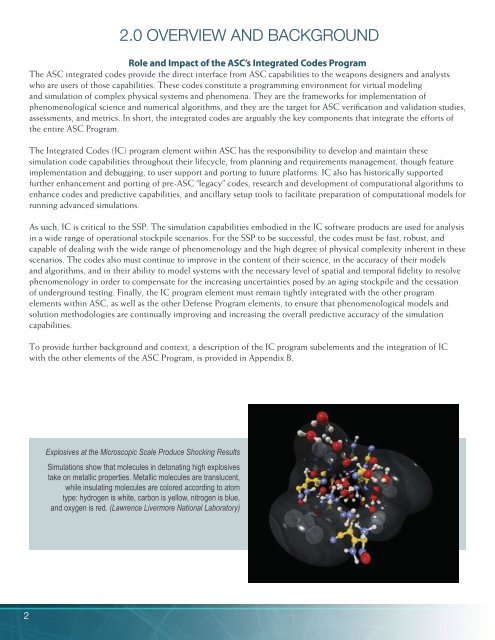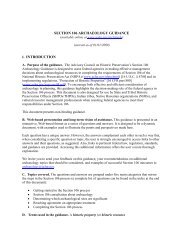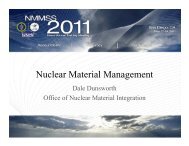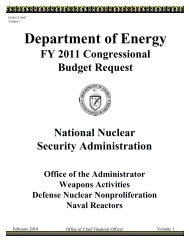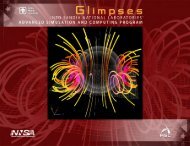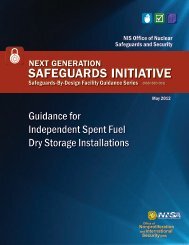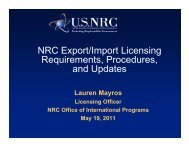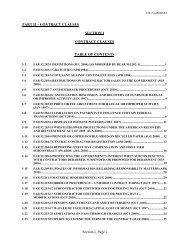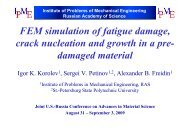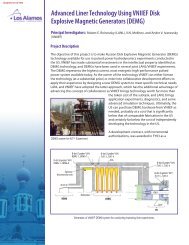ASC Code Strategy - National Nuclear Security Administration
ASC Code Strategy - National Nuclear Security Administration
ASC Code Strategy - National Nuclear Security Administration
You also want an ePaper? Increase the reach of your titles
YUMPU automatically turns print PDFs into web optimized ePapers that Google loves.
2.0 OVERVIEW AND BACKGROUND<br />
Role and Impact of the <strong>ASC</strong>’s Integrated <strong>Code</strong>s Program<br />
The <strong>ASC</strong> integrated codes provide the direct interface from <strong>ASC</strong> capabilities to the weapons designers and analysts<br />
who are users of those capabilities. These codes constitute a programming environment for virtual modeling<br />
and simulation of complex physical systems and phenomena. They are the frameworks for implementation of<br />
phenomenological science and numerical algorithms, and they are the target for <strong>ASC</strong> verification and validation studies,<br />
assessments, and metrics. In short, the integrated codes are arguably the key components that integrate the efforts of<br />
the entire <strong>ASC</strong> Program.<br />
The Integrated <strong>Code</strong>s (IC) program element within <strong>ASC</strong> has the responsibility to develop and maintain these<br />
simulation code capabilities throughout their lifecycle, from planning and requirements management, though feature<br />
implementation and debugging, to user support and porting to future platforms. IC also has historically supported<br />
further enhancement and porting of pre-<strong>ASC</strong> “legacy” codes, research and development of computational algorithms to<br />
enhance codes and predictive capabilities, and ancillary setup tools to facilitate preparation of computational models for<br />
running advanced simulations.<br />
As such, IC is critical to the SSP. The simulation capabilities embodied in the IC software products are used for analysis<br />
in a wide range of operational stockpile scenarios. For the SSP to be successful, the codes must be fast, robust, and<br />
capable of dealing with the wide range of phenomenology and the high degree of physical complexity inherent in these<br />
scenarios. The codes also must continue to improve in the content of their science, in the accuracy of their models<br />
and algorithms, and in their ability to model systems with the necessary level of spatial and temporal fidelity to resolve<br />
phenomenology in order to compensate for the increasing uncertainties posed by an aging stockpile and the cessation<br />
of underground testing. Finally, the IC program element must remain tightly integrated with the other program<br />
elements within <strong>ASC</strong>, as well as the other Defense Program elements, to ensure that phenomenological models and<br />
solution methodologies are continually improving and increasing the overall predictive accuracy of the simulation<br />
capabilities.<br />
To provide further background and context, a description of the IC program subelements and the integration of IC<br />
with the other elements of the <strong>ASC</strong> Program, is provided in Appendix B.<br />
Explosives at the Microscopic Scale Produce Shocking Results<br />
Simulations show that molecules in detonating high explosives<br />
take on metallic properties. Metallic molecules are translucent,<br />
while insulating molecules are colored according to atom<br />
type: hydrogen is white, carbon is yellow, nitrogen is blue,<br />
and oxygen is red. (Lawrence Livermore <strong>National</strong> Laboratory)<br />
2


